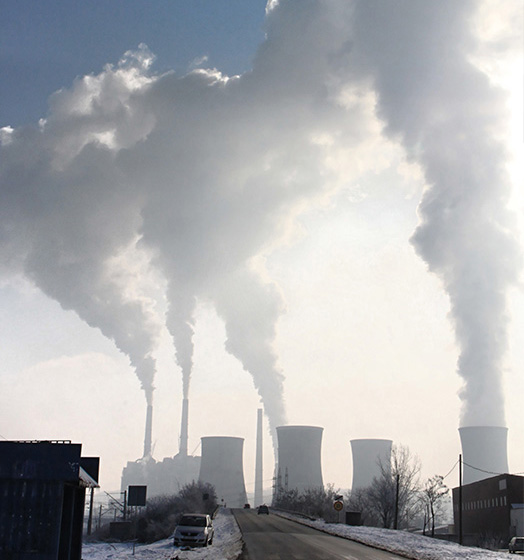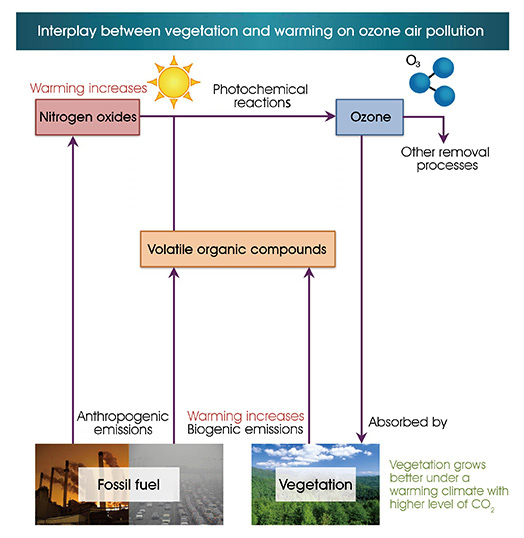Safeguarding Air Quality, Ecosystems and Food Security Requires a Unified Approach
Prof. Amos P. K. Tai
Earth System Science Programme
Outdoor air pollution is one of the most severe environmental threats we are facing today, responsible for more than three million deaths a year worldwide. Mitigation efforts thus far have mostly focused on reducing emissions from industrial and vehicular sources. Many studies have, however, shown that, as the chemistry of air is an integral part of the Earth system, changes happening to our climate, land surface and ecosystems can affect air quality to various extents, and may in some regions compromise our emission control efforts. Let me illustrate a few interesting examples from our own research.


Surprising Link between Plants and Pollution
Not commonly known, land plants indeed play an important role shaping air quality through a complex array of pathways. They help us remove toxic pollutants including surface ozone from the air as they passively absorb them through their leaf openings. On the other hand, many species of trees emit large amounts of volatile organic compounds (VOCs) whenever conditions are warm, moist and sunny. These compounds often serve important functions for the trees, such as scaring away leaf-eating insects or attracting pollinators, and are generally harmless to human health.
However, if the air is pre-loaded with nitrogen oxides (called NOx) emitted mostly from vehicles, VOCs undergo a cascade of chemical reactions with NOx to produce ozone, which if present near the surface is very harmful for human health. In our recent study, we used a computer model to examine what factors have shaped ozone air quality in China, and found that over the past three decades, unsurprisingly, increasing industrial and vehicular emissions are the largest driver of increasing ozone levels, contributing to about 28,000 more deaths per year now in China than 30 years ago.
On the other hand, we also discovered that regional warming has also elevated ozone levels and contributed to about 4,400 more deaths per year compared to 30 years ago, thus greatly exacerbating the effect of rising anthropogenic emissions. The climate-driven increase in ozone mostly has to do with tree emissions of VOCs, which increase with temperature. The enhanced VOCs thus react with high level of preexisting NOx to form more ozone. Although vegetation has generally fared better under warming and higher CO2, with higher leaf density to remove pollutants from air, the ozone increase due to rising tree VOCs has more than offset the higher ozone absorption by leaves.
This is, emphatically, not to say that trees are the culprit – these VOCs are harmful only under high levels of NOx from cars and factories! It only implies that more stringent control measures for vehicular NOx than currently planned will be needed to brace us for the complicating effects of climate change. But it also implies that urban greening, which has a huge array of benefits for the urban environment, has to be done vigilantly with careful selection of tree species that emit no or only low level of VOCs.
Interaction between Air and Agriculture
Another example is related to agriculture. Air pollutants such as ozone are detrimental not only to human health but also to crop growth. In our earlier study, we found that global warming and unchecked levels of air pollutants may have the potential to increase the population of undernourished people in developing countries by up to 50% in the mid-21st century. We further found that if we implement stringent measures against air pollution, the increase in the undernourishment rate could be much smaller, implying that pollution control policy can have the co-benefit of reducing food insecurity for vulnerable populations.

Furthermore, air pollution control, often targeting industrial sources only, may also be more effective if agricultural planning becomes an integral element. It is now widely known that ammonia-based fertilizer used in conventional large-scale farming is one of the major contributors to particulate matter pollution through the formation of ammonium nitrate particles. Sustainable farming methods that are shown to reduce fertilizer application, such as intercropping and crop rotation with soybean, should therefore be more widely promoted as a means not only of securing crop yield and soil health, but also of tackling air pollution.

In light of the above examples, we see that the issues of air pollution, climate change, ecosystem management and food production are intimately connected with one another. Tackling one issue without due consideration of the others may indeed create unexpected consequences that may compromise the intended goals. We therefore strongly call for greater communication and collaboration between scientists, agencies and stakeholders on these various issues, across traditional, bureaucratic and institutional barriers. Only then would we be able to derive balanced, optimal strategies for all of these daunting environmental and resource issues under a unified, coordinated framework.


